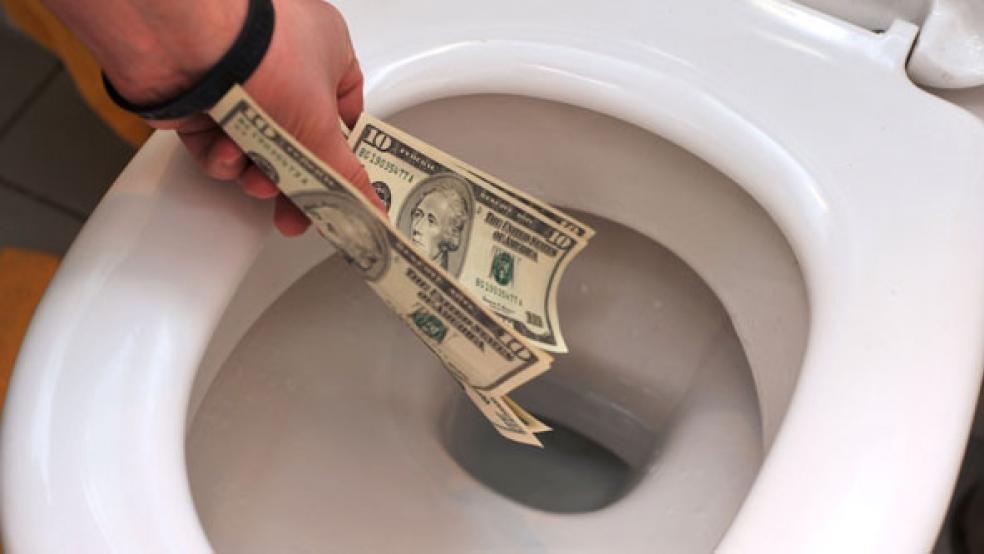If you are a federal worker on furlough this week — or an airline passenger delayed by federal furloughs — you might save your blood pressure, and go read another story. This one is about all the money the U.S. government spends on . . . nothing.
It is one of the oddest spending habits in Washington: This year, the government will spend at least $890,000 on service fees for bank accounts that have nothing in them. At last count, Uncle Sam has 13,712 such accounts, each with a balance of zero.

These are supposed to be closed. But nobody has done the paperwork yet.
So even now, as the sequester budget cuts have begun idling workers and frustrating travelers, the government is still required to pay $65, per year, per account, to keep these empty accounts on the books.
RELATED: GOP Says Obama ‘Manufactured’ Air Traffic Crisis
In this time of austerity, the accounts are a reminder of something that makes austerity hard: expensive habits, built into the bureaucracy in times of plenty. The Obama administration has spent the past year trying to close these accounts, with some success. But only some.
“If anyone had kept open a bank account with no money, and was getting a charge every month, they would do everything they could to close it,” said Thomas A. Schatz, of the watchdog group Citizens Against Government Waste. But, Schatz said, the government hasn’t shown the same kind of urgency with taxpayers’ money.
“It’s just lack of attention to detail. And poor management,” he said. “And, clearly, the fact that no one gets penalized for paying money to keep the accounts open.”
The money spent on the empty accounts is, of course, a tiny fraction of the federal budget. But, in its own way, it is something special: Washington’s perfect waste, a rare specimen of cost untainted by any reward. The Pentagon once paid $435 for a hammer, after all. But at least, in that case, it got a hammer.
Here, when the money is spent, “there’s no benefit whatsoever,” said Sen. Tom Coburn (R-Okla.), who has joined Sen. Thomas R. Carper (D-Del.) in pushing the Obama administration to close these accounts faster.
Inside the administration, officials said they’re trying. Last year, the Office of Management and Budget urged agencies to crack down on these “zero balance” accounts. And this year, it proposed a wide-scale effort to improve their oversight.
“We have worked with agencies to improve the timely closeout of grants,” said Danny Werfel, the controller at the Office of Management and Budget, in an e-mail. “Agencies have made noteworthy progress so far, with the number of zero balance accounts falling by more than 50 percent since the end of fiscal year 2011.” Back then, the total was more than 28,000.
Here is how the government winds up spending money on nothing:
First, a federal agency gives out a grant. It doesn’t just write a check; it creates an account within a large, government-run depository. The grantee can draw money out from there.
Then, at some point, it’s over. The money runs out. Or the grant’s time limit expires. The agency is given notice: It’s time to close the account down.

Right now, about 7 percent of the 202,000 total government grant accounts are devoid of money. These sit on the books, costing about $5.42 per month. The service fees are the same, whether an account is full or empty.
Last year, the Government Accountability Office found that all that nothing was costing about $2.1 million a year. The GAO reported that this was not a great idea. “Agencies paying fees for expired accounts with zero dollar balance are paying for services that are not needed,” the watchdog agency noted, without irony.
Around Washington, there are plenty of problems like this one — old bugs, built into the machine of government, that make spending money seem easier than saving it. Things like the red tape that delays the sale of excess government buildings, or the long-standing tolerance of duplication. Right now, for instance, six different government agencies have already launched separate projects to do the same thing: build a computer program to track personnel background checks.
Last summer, the Obama administration sought to fix this particular bug. It sent a memo to agencies: “Focus first on closing out expired grants that are several years past their end dates or have no remaining funds.”
In some places, it apparently didn’t work. The U.S. Agency for International Development has the same amount of empty accounts now that it did in 2011. The Fish and Wildlife Service didn’t provide new numbers at all, despite a request from The Washington Post.
But in other places, it did. The Department of Agriculture eliminated 74 percent of its empty accounts, saving itself $90,000 per year. The National Park Service closed all 705 empty accounts and got its total down to zero. There was also success at the Department of Health and Human Services. It had previously been paying for 21,000 empty accounts; now, the total is down to 9,286: a major cut, but still an expense of about $604,000 per year. Could the agency get that number lower?
Officials answered the question this way: They could never imagine getting it to zero. The government would always have to spend something on nothing.
“We will continue our efforts to accelerate grant closeouts,” said Nancy Gunderson, who oversees grants at Health and Human Services. “These accounts are a normal part of the grants business cycle and will never be totally eliminated.”
This article originally appeared in The Washington Post.




